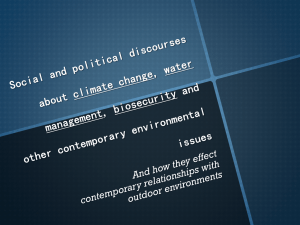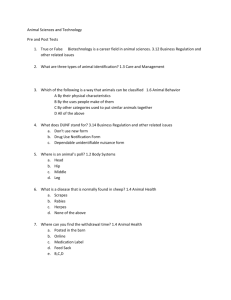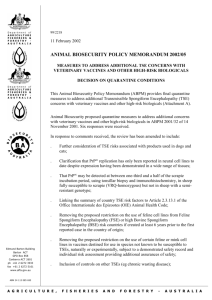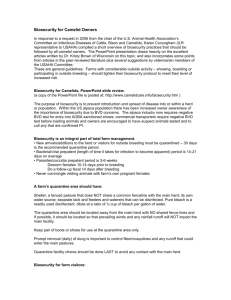42 KB - Department of Agriculture
advertisement
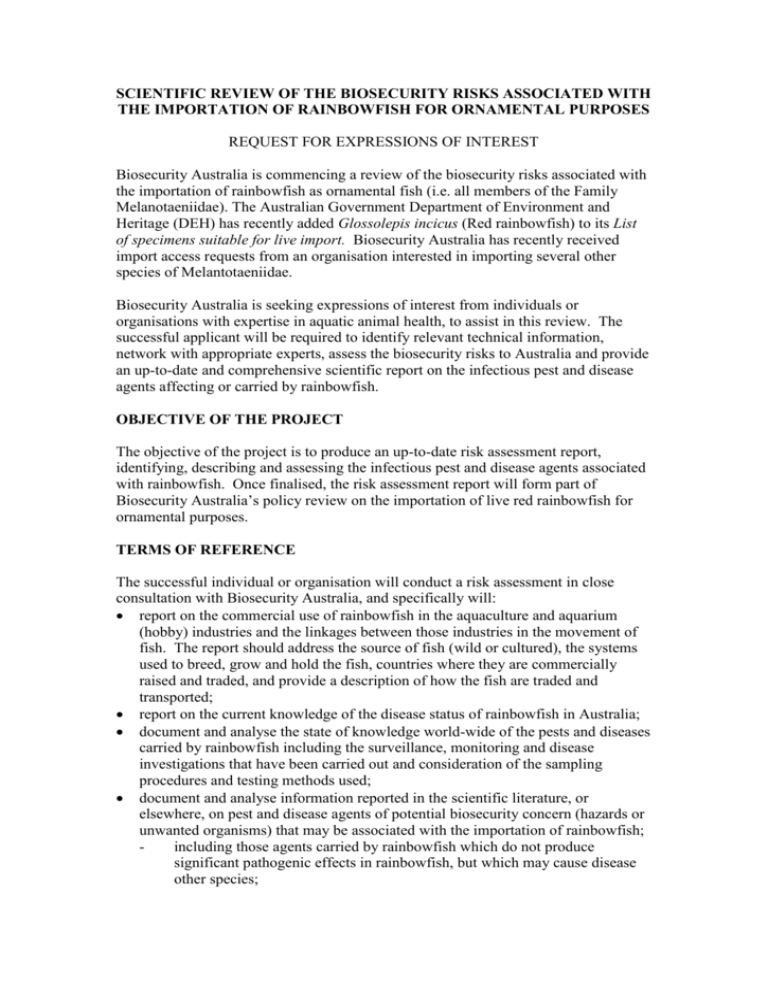
SCIENTIFIC REVIEW OF THE BIOSECURITY RISKS ASSOCIATED WITH THE IMPORTATION OF RAINBOWFISH FOR ORNAMENTAL PURPOSES REQUEST FOR EXPRESSIONS OF INTEREST Biosecurity Australia is commencing a review of the biosecurity risks associated with the importation of rainbowfish as ornamental fish (i.e. all members of the Family Melanotaeniidae). The Australian Government Department of Environment and Heritage (DEH) has recently added Glossolepis incicus (Red rainbowfish) to its List of specimens suitable for live import. Biosecurity Australia has recently received import access requests from an organisation interested in importing several other species of Melantotaeniidae. Biosecurity Australia is seeking expressions of interest from individuals or organisations with expertise in aquatic animal health, to assist in this review. The successful applicant will be required to identify relevant technical information, network with appropriate experts, assess the biosecurity risks to Australia and provide an up-to-date and comprehensive scientific report on the infectious pest and disease agents affecting or carried by rainbowfish. OBJECTIVE OF THE PROJECT The objective of the project is to produce an up-to-date risk assessment report, identifying, describing and assessing the infectious pest and disease agents associated with rainbowfish. Once finalised, the risk assessment report will form part of Biosecurity Australia’s policy review on the importation of live red rainbowfish for ornamental purposes. TERMS OF REFERENCE The successful individual or organisation will conduct a risk assessment in close consultation with Biosecurity Australia, and specifically will: report on the commercial use of rainbowfish in the aquaculture and aquarium (hobby) industries and the linkages between those industries in the movement of fish. The report should address the source of fish (wild or cultured), the systems used to breed, grow and hold the fish, countries where they are commercially raised and traded, and provide a description of how the fish are traded and transported; report on the current knowledge of the disease status of rainbowfish in Australia; document and analyse the state of knowledge world-wide of the pests and diseases carried by rainbowfish including the surveillance, monitoring and disease investigations that have been carried out and consideration of the sampling procedures and testing methods used; document and analyse information reported in the scientific literature, or elsewhere, on pest and disease agents of potential biosecurity concern (hazards or unwanted organisms) that may be associated with the importation of rainbowfish; including those agents carried by rainbowfish which do not produce significant pathogenic effects in rainbowfish, but which may cause disease other species; in consultation with Biosecurity Australia provide in the risk assessment report a preliminary assessment for each pest or disease agent in terms of their biosecurity concern (this preliminary assessment will eliminate from further detailed assessment those agents that clearly do not present a significant biosecurity concern); include a detailed assessment of quarantine risk associated with each pest and disease agent found to be of biosecurity concern, including the likelihood of each agent entering, establishing and/or spreading in Australia together with the potential consequences that would result. The successful tenderer will be expected to consult with Biosecurity Australia on methodological issues; ensure the report is fully referenced; submit a draft report in electronic and hard copy form to Biosecurity Australia by a date agreed by both parties; and submit a final report (electronic and hard copy) within two weeks, or other agreed period, of receipt of final comments from Biosecurity Australia. STANDARD OF REPORT The consultant should prepare the final report to a standard that is consistent with the standard of reports produced in the course of import risk analyses conducted by Biosecurity Australia. The report must be of quality suitable for publication in a peerreviewed journal. Once finalised, it will form part of Biosecurity Australia’s policy review on the importation of live rainbowfish for ornamental purposes. Examples of import risk analysis reports may be found at Biosecurity Australia's website: www.daff.gov.au/animalbiosecurity TERMS AND CONDITIONS The following information should be provided for each pest or disease agent: 1. Agent characteristics (name, taxonomy and description of agent) 2. Epidemiological features of disease including: (a) geographical range and features of distribution (including any evidence of international spread), (b) host factors (including zoonotic potential, any evidence of resistant strains/species, susceptibility of different life stages of the host, course of infection, morbidity/mortality rates and seasonality, (c) prevalence and incidence in endemic situations or during outbreaks, and (d) transmission (including route and infectious dose) 3. Pathogenic effects: (a) key diagnostic features, (b) tissue tropism, (c) major pathological and biological effects 4. Diagnostic methods, including their specificity and sensitivity 5. Disease management, including (a) through the use of husbandry and environment management techniques, (b) the use of therapeutics, (c) the effectiveness of the identified control methods 6. A description of the plausible pathways by which the agent may be introduced to Australia (release) with the importation of rainbowfish and be exposed to susceptible host species in Australia (exposure), including description of the significant steps in this pathway that may influence the probability of this event occurring. 7. An assessment of the probability of release and exposure pathways being completed. 8. Assuming that the pathway were to be successfully completed, describe the likely harm that would result in biological, economic, environmental and social terms. The description should include the direct and indirect harm that would result from the establishment and/or spread of the agent to susceptible host populations in Australia. An assessment of the likely magnitude of the harm that would result should be made. Australian Public Service terms and conditions regarding short-term contracts with external consultants apply to this proposal. EXPRESSIONS OF INTEREST Based on the Terms of Reference the applicant should provide Biosecurity Australia with a written expression of interest that contains the following information: . . . . . . Name of individual or organisation Person or persons who would carry out the consultancy and their relationship to the consultant, company or institution Previous experience of the nominated personnel in conducting similar assignments An outline of how the assignment would be carried out, including milestones with identified timeframes An estimated costing, including report writing and travel expenses (if costed separately) Provide a statement of agreement with the draft contract or identify any variations that they would be seeking if offered the consultancy Expressions of interest should be forwarded to: General Manager Animal Biosecurity Biosecurity Australia DAFF Tender Box, Core 1 Edmund Barton Building BARTON ACT 2600 and must be received by 2:00pm 1 May 2006. Biosecurity Australia will assess all expressions of interest and will contact the successful applicants as soon as possible after the closing date. The lowest tenders will not necessarily be accepted. For further information please contact Cameron Tomkinson by e-mail cameron.tomkinson@daff.gov.au or telephone (02) 6271 6540.
